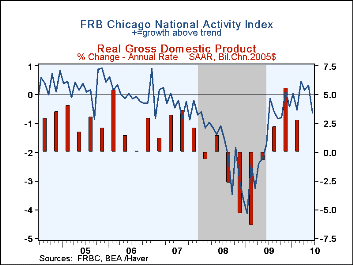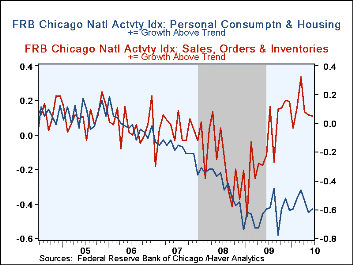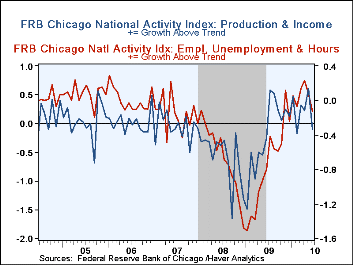 Global| Jul 26 2010
Global| Jul 26 2010U.S. Economic Momentum Lost: Chicago Fed Index Reverses Seven Months Of Improvement
by:Tom Moeller
|in:Economy in Brief
Summary
Economic activity began this summer on a sour note. The June National Activity Index (CFNAI), reported by the Chicago Fed, fell to -0.63 which was the lowest level since last October. Moreover, prior months' improvement was hardly [...]
 Economic activity began this summer on a sour note. The June National
Activity Index (CFNAI), reported by the Chicago Fed, fell to -0.63 which was the
lowest level since last October. Moreover, prior months' improvement was hardly
indicative of a gangbuster economic recovery, but this latest reading supports
the message from other economic series that the current recovery has hit a soft
patch. Nevertheless, the index remained up from it low of -4.12 reached in
January '09. During the last ten years the has been a 76% correlation between
the index level and the q/q change in real GDP.
Economic activity began this summer on a sour note. The June National
Activity Index (CFNAI), reported by the Chicago Fed, fell to -0.63 which was the
lowest level since last October. Moreover, prior months' improvement was hardly
indicative of a gangbuster economic recovery, but this latest reading supports
the message from other economic series that the current recovery has hit a soft
patch. Nevertheless, the index remained up from it low of -4.12 reached in
January '09. During the last ten years the has been a 76% correlation between
the index level and the q/q change in real GDP.
The three-month moving average of the index, which smoothes out some of the series' volatility, also fell to its lowest level since February.
An index level at or below -0.70 typically has indicated negative U.S. economic growth. A zero value of the CFNAI indicates that the economy is expanding at its historical trend rate of growth of roughly 3.0%. The complete CFNAI report is available here.
The Chicago Fed indicated that the loss of forward momentum was broad based amongst the component series, but most notable in the job market indicators and the production & income readings which went negative after months of positive values. Thirty-six of the 85 individual indicators made positive contributions to the index in June, while 49 made negative contributions.Twenty-nine indicators improved from May to June, while 56 indicators deteriorated.
The CFNAI is a weighted average of 85 indicators of economic activity. The indicators reflect activity in the following categories: production & income, the labor market, personal consumption & housing, manufacturing & trade sales, and inventories & orders.
In a separate survey, the Chicago Fed indicated that its Midwest manufacturing index improved during May to its highest level since December 2008. Indicators for the steel, machinery and resource sectors each rose. The Chicago Federal Reserve figures are available in Haver's SURVEYS database.
Tom Moeller
AuthorMore in Author Profile »Prior to joining Haver Analytics in 2000, Mr. Moeller worked as the Economist at Chancellor Capital Management from 1985 to 1999. There, he developed comprehensive economic forecasts and interpreted economic data for equity and fixed income portfolio managers. Also at Chancellor, Mr. Moeller worked as an equity analyst and was responsible for researching and rating companies in the economically sensitive automobile and housing industries for investment in Chancellor’s equity portfolio. Prior to joining Chancellor, Mr. Moeller was an Economist at Citibank from 1979 to 1984. He also analyzed pricing behavior in the metals industry for the Council on Wage and Price Stability in Washington, D.C. In 1999, Mr. Moeller received the award for most accurate forecast from the Forecasters' Club of New York. From 1990 to 1992 he was President of the New York Association for Business Economists. Mr. Moeller earned an M.B.A. in Finance from Fordham University, where he graduated in 1987. He holds a Bachelor of Arts in Economics from George Washington University.








